Diversity and financial returns in higher education in Peru

Shared value is Porter’s and Kramer’s enlightened version of capitalism, stating that social and financial value can be co-created and have an inter-causal impact on a company’s bottom line. In USIL’s case, this means that offsetting social inclusion and more diversity of students that lack money to study must not be purely altruistic - it actually can have a financial return: Attracting more external student funding by offering donors a guarantee will attract more students, thus more business for USIL, leading to an overall better reputation and a more robust business model over time.
Based on a complex financial structure by itself, designed in a 5-month’s shared value appraisal with the IDB’s Structured Corporate Finance Department (e.g. calculating how many high-risk students have to be balanced out with lower-risk ones over x-amount of time), USIL’s guarantee fund will only be as good as the university’s efforts to retain and graduate more vulnerable students: If a student backed up by the student guarantee fund drops out, USIL has to step in and pay the external donor back a full-time scholarship or –loan (the latter only applies to low-risk students).
For this not to happen, USIL wants to accompany more vulnerable students holistically, not just their wallets. The differentiated support structure includes academic and personal tutoring, vocational skill training, assistance of how to find a stable and safe housing situation in a large metropolis, an internship to facilitate labor market insertion, and sometimes even clothing. The dean of the university says that USIL aims to attain a zero drop-out rate – an ambitious but feasible goal. With a low drop-out rate, the guarantee fund will not be touched and guarantee new, incoming students.
What is the future of the student guarantee fund? Especially the scholarship part of the fund will not be possible without financially partnering with some of Peru’s largest private sector companies. Hopefully over time the fund will show mainstream corporate investors that the financial risk associated with lower-income students can be well mitigated if a committed university does its job well. 
If this idea and the innovative model behind work the way we envision, and more universities would like to design similar funds with us, it will be a mayor break-through in student financing for higher education in LAC and other developing regions. It will also be an incentive for companies in LAC to mobilize more of their financial resources and to be part of innovation - by educating a more diverse and competitive labor force for their own and a country’s future.
To read related blogs, please visit ¿Y si hablamos de igualdad?: http://blogs.iadb.org/y-si-hablamos-de-igualdad/
LIKE WHAT YOU JUST READ?
Subscribe to our mailing list to stay informed on the latest IDB Invest news, blog posts, upcoming events, and to learn more about specific areas of interest.
Subscribe



